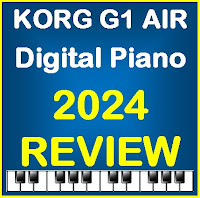 UPDATED REVIEW – June 1, 2024 – Korg G1 Air (aka: G1B Air) priced at $1999 is the top of the line Korg home digital piano. It competes with many top name digital pianos that are priced at hundreds of dollars more and we believe this impressive Korg model offers a bigger bang for the buck than most other brands and models at or near $2000. We talk about the “reasons why” in our detailed review below.
UPDATED REVIEW – June 1, 2024 – Korg G1 Air (aka: G1B Air) priced at $1999 is the top of the line Korg home digital piano. It competes with many top name digital pianos that are priced at hundreds of dollars more and we believe this impressive Korg model offers a bigger bang for the buck than most other brands and models at or near $2000. We talk about the “reasons why” in our detailed review below. Korg also currently produces a myriad of high quality advanced keyboards, synths, pro guitar effects products, portable organs, digital percussion, and many other pro music gear products. I have personally played on Korg pro digital pianos including the latest Kronos models and going all the way back to the T1, Triton, and M1 years ago. Back in the early 1990’s Korg was actually a leader in the digital piano home market producing some of the best home furniture cabinet digital pianos in the business and I use to play many of those pianos including the popular C3500 & C5000.
Korg also currently produces a myriad of high quality advanced keyboards, synths, pro guitar effects products, portable organs, digital percussion, and many other pro music gear products. I have personally played on Korg pro digital pianos including the latest Kronos models and going all the way back to the T1, Triton, and M1 years ago. Back in the early 1990’s Korg was actually a leader in the digital piano home market producing some of the best home furniture cabinet digital pianos in the business and I use to play many of those pianos including the popular C3500 & C5000.Finally, within the last 5 years, Korg has finally come back into the home furniture cabinet digital piano business (I am glad they did) with some very impressive newer models including the G1 Air.
 The Korg G1 (aka: G1B Air) comes in 3 cabinet colors including matte black, darker matte brown, and matte white. The G1 Air also has a newly redesigned cabinet with the addition of a “privacy panel” on the back of the cabinet so that you cannot “see through it” any longer. On the previous model there was no privacy panel so it was completely open in the back. The addition of this privacy panel gives this model an upgraded appearance and now it looks more elegant and finished as you can see on the top 2 photos of the piano in this review. The rest of the piano including all digital features functions, internal speaker system, etc, is still the same. However, Korg did improved the fit & finish on these models along with some internal improvements in the new version as compared to the previous version.
The Korg G1 (aka: G1B Air) comes in 3 cabinet colors including matte black, darker matte brown, and matte white. The G1 Air also has a newly redesigned cabinet with the addition of a “privacy panel” on the back of the cabinet so that you cannot “see through it” any longer. On the previous model there was no privacy panel so it was completely open in the back. The addition of this privacy panel gives this model an upgraded appearance and now it looks more elegant and finished as you can see on the top 2 photos of the piano in this review. The rest of the piano including all digital features functions, internal speaker system, etc, is still the same. However, Korg did improved the fit & finish on these models along with some internal improvements in the new version as compared to the previous version.
 Air.” The G1 Air is without question one of the best selling, most popular furniture cabinet digital pianos under $2000. After personally playing and analyzing this the G1 Air, in my opinion Korg has managed to surpass some of the other top name brands in this price range for a home digital piano including Roland, Yamaha, and Kawai. Korg pianos and keyboards have always been very popular with pro players around the world and over the past 10 years they having a positive growing reputation with families and piano students.
Air.” The G1 Air is without question one of the best selling, most popular furniture cabinet digital pianos under $2000. After personally playing and analyzing this the G1 Air, in my opinion Korg has managed to surpass some of the other top name brands in this price range for a home digital piano including Roland, Yamaha, and Kawai. Korg pianos and keyboards have always been very popular with pro players around the world and over the past 10 years they having a positive growing reputation with families and piano students.But this brand is still not as well known as Yamaha, Casio, Kawai, and Roland for home digital pianos. However, Korg takes its advanced digital piano technology from their higher priced pro digital stage pianos that sell for up to $4000 and they put some of that advanced sound and key action technology in their home digital piano line and that is what makes Korg so good with regard to home digital pianos…they know what they are doing and they do it well.
KEY ACTION
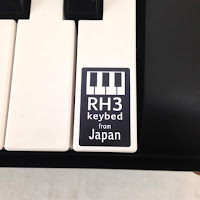 So what are the things that makes the Korg G1 Air so good and why do I like it? First of all the piano key action is amazing in my opinion but that should come as no surprise to me because it is the same key action that Korg uses for their top of the line professional Kronos stage digital pianos and I have played those instruments many times. A key action needs to be properly weighted, graded, and responsive not only in touch but how it triggers the piano sound from a light gentle touch to a hard touch, and for a fast movement of your fingers across the keys. As I have talked about in my other reviews, the quality and movement of the key action is 1st and foremost when shopping for and considering a digital piano.
So what are the things that makes the Korg G1 Air so good and why do I like it? First of all the piano key action is amazing in my opinion but that should come as no surprise to me because it is the same key action that Korg uses for their top of the line professional Kronos stage digital pianos and I have played those instruments many times. A key action needs to be properly weighted, graded, and responsive not only in touch but how it triggers the piano sound from a light gentle touch to a hard touch, and for a fast movement of your fingers across the keys. As I have talked about in my other reviews, the quality and movement of the key action is 1st and foremost when shopping for and considering a digital piano.Also, just like on regular acoustic upright and grand pianos, the white key tops are made of a synthetic gloss white acrylic and the black keytops have a matte black finish on them which is nice so that you could more easily transition from this digital piano to a real acoustic piano without noticing much of a difference at all, especially when comparing the G1 Air to a fine upright acoustic piano.
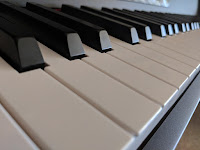

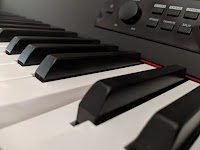 I will also mention that when shopping for a new digital piano there are a couple other things that you’ll want to consider with regard to key action. You will notice that many of the other brands have key actions with “synthetic” ivory and ebony keytops. What that means is that the feel of the keytops are trying to simulate what real ivory and ebony feels like to the fingers because many decades ago older pianos were able to use real organic elephant ivory and African ebony wood to make their key tops.
I will also mention that when shopping for a new digital piano there are a couple other things that you’ll want to consider with regard to key action. You will notice that many of the other brands have key actions with “synthetic” ivory and ebony keytops. What that means is that the feel of the keytops are trying to simulate what real ivory and ebony feels like to the fingers because many decades ago older pianos were able to use real organic elephant ivory and African ebony wood to make their key tops.PIANO SOUND REALISM
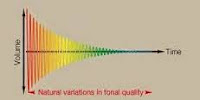 The next important thing that people are looking for is accurate, natural piano sound…but what does that mean? Piano sound can vary in a number of way from one piano to another, one brand to another, and one model to another when it comes to real acoustic pianos and how they sound. They can have a bright, medium bright, more mellow, very mellow or delicate tone with dynamic tonal expression, or without dynamic tonal expression. The main aspect and goal of a great piano sound is…can it play music in a very delicate and mellow way all the way to big, bold, and dynamic tone while offering a great amount of musical color and expression all in one piano? The answer is “YES” but as long as it is a great grand piano such as the ones played in symphony concert halls of by famous jazz or pop piano players such as Billy Joel, Elton John, Duke Ellington, Oscar Peterson, etc.
The next important thing that people are looking for is accurate, natural piano sound…but what does that mean? Piano sound can vary in a number of way from one piano to another, one brand to another, and one model to another when it comes to real acoustic pianos and how they sound. They can have a bright, medium bright, more mellow, very mellow or delicate tone with dynamic tonal expression, or without dynamic tonal expression. The main aspect and goal of a great piano sound is…can it play music in a very delicate and mellow way all the way to big, bold, and dynamic tone while offering a great amount of musical color and expression all in one piano? The answer is “YES” but as long as it is a great grand piano such as the ones played in symphony concert halls of by famous jazz or pop piano players such as Billy Joel, Elton John, Duke Ellington, Oscar Peterson, etc.The Korg G1 Air really surprised me with all of the musical colors and dynamic tonal range that it has. It’s one thing to have a really good key action but it’s an entirely different thing to also have a satisfying acoustic piano sound experience and the G1 Air delivers on that point too.
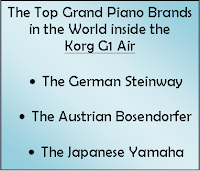 Almost all of the digital piano companies out there claim to copy or sample a full grand piano sound and put it into their digital pianos…but that is easier said than done. Copying or sampling a piano sound is just the first step of the process, but then that digital piano company needs to have copied that sound from a quality grand piano with the proper microphones, the proper technology, and then put all that into their digital system which can then hopefully correctly translate it into the digital piano so when you play it then that sound comes out sounding real and natural rather than fake and artificial. In my opinion the Korg G1 Air gets extremely close to sounding like it is not a digital piano but instead a real acoustic piano, and that is really hard to do, especially in this price range under $2000.
Almost all of the digital piano companies out there claim to copy or sample a full grand piano sound and put it into their digital pianos…but that is easier said than done. Copying or sampling a piano sound is just the first step of the process, but then that digital piano company needs to have copied that sound from a quality grand piano with the proper microphones, the proper technology, and then put all that into their digital system which can then hopefully correctly translate it into the digital piano so when you play it then that sound comes out sounding real and natural rather than fake and artificial. In my opinion the Korg G1 Air gets extremely close to sounding like it is not a digital piano but instead a real acoustic piano, and that is really hard to do, especially in this price range under $2000.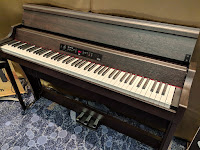 G1 Air has 7 acoustic multi-sampled piano sounds which are accessed on the control panel with a row of three buttons. The first button accesses what Korg calls “G” grand piano sounds and the “G” stands for a German Steinway grand piano. Each button has 3 variations of piano so every time you press that button the sound advances to the next piano sound in that sound bank. The next Button is the “A” grand piano sounds which stand for an Austrian Grand Piano otherwise known as Bosendorfer and there are variations within that button of the Bosendorfer grand piano sound that are different from each other.
G1 Air has 7 acoustic multi-sampled piano sounds which are accessed on the control panel with a row of three buttons. The first button accesses what Korg calls “G” grand piano sounds and the “G” stands for a German Steinway grand piano. Each button has 3 variations of piano so every time you press that button the sound advances to the next piano sound in that sound bank. The next Button is the “A” grand piano sounds which stand for an Austrian Grand Piano otherwise known as Bosendorfer and there are variations within that button of the Bosendorfer grand piano sound that are different from each other.Likewise, you would never see a Steinway grand piano sound in a Yamaha digital piano because those two companies are fierce competitors in the acoustic piano world. Korg does not have that issue because as I said, they don’t build acoustic pianos so they have more freedom to use different high quality acoustic piano samples in their digital pianos.
Since Korg does not build real acoustic pianos then how come their piano sounds in the G1 Air are so realistic with so much tonal color and expression which all great pianists seek when shopping for a piano? We’ll, just because you don’t build real acoustic pianos does not mean you don’t know how they work and what goes into them. Korg has an experienced staff of professional pianists along with outside professional tech support from top rated concert piano technicians/tuners who are advisers to Korg piano division. Beyond that, Korg has digital music technology that is so advanced that they have won many awards throughout the world over the years from big name industry leaders for their advanced proprietary sound technology which they also use in their stage pianos.
 Then when you mix two different stereo acoustic piano tones together which you can do on this piano, then you can have the best of both worlds in terms of the personality and character of that mixed stereo piano sound.As an example you can combine Austrian Bosendorfer with German Steinway or Japanese Yamaha with Austrian Bosendorfer and you can select which version of each piano to combine with the other one. When you make those combinations it really is like hearing both pianos playing at the same time mixing their unique stereo tonal qualities qualities together in a way I have not heard before on any digital piano in this price range.
Then when you mix two different stereo acoustic piano tones together which you can do on this piano, then you can have the best of both worlds in terms of the personality and character of that mixed stereo piano sound.As an example you can combine Austrian Bosendorfer with German Steinway or Japanese Yamaha with Austrian Bosendorfer and you can select which version of each piano to combine with the other one. When you make those combinations it really is like hearing both pianos playing at the same time mixing their unique stereo tonal qualities qualities together in a way I have not heard before on any digital piano in this price range.
 I can tell you by experience as a long time piano teacher and pro musician that different people like the sound of different pianos.A piano sound that I may like, another person may not personally like that sound as much…and that’s OK because we all have different ears. The point is that at least on this Korg G1 Air piano you have 7 different acoustic piano tones coming from 3 distinct grand pianos to choose from plus all the combinations you can get when mixing them so you are likely to find one or more piano sounds that really speak to you.
I can tell you by experience as a long time piano teacher and pro musician that different people like the sound of different pianos.A piano sound that I may like, another person may not personally like that sound as much…and that’s OK because we all have different ears. The point is that at least on this Korg G1 Air piano you have 7 different acoustic piano tones coming from 3 distinct grand pianos to choose from plus all the combinations you can get when mixing them so you are likely to find one or more piano sounds that really speak to you.POLYPHONY
 One thing that is especially important for me to mention here is the polyphony specification of the G1 Air. Polyphony is a number that a lot of digital piano shoppers don’t really understand at all or maybe they think they understand it but they really don’t. Either way, the polyphony number (amount of maximum notes that can be heard playing simultaneously) of a digital piano can play an important part in the ability of the piano to play the piano and instrument sounds in a way that sound good and natural.
One thing that is especially important for me to mention here is the polyphony specification of the G1 Air. Polyphony is a number that a lot of digital piano shoppers don’t really understand at all or maybe they think they understand it but they really don’t. Either way, the polyphony number (amount of maximum notes that can be heard playing simultaneously) of a digital piano can play an important part in the ability of the piano to play the piano and instrument sounds in a way that sound good and natural.
A few decades ago it was not uncommon to see digital pianos have 12-note polyphony, then 24 note, 32-note, and then as the years went by and digital piano technology got better you would 48-note, 64-note, 92-note, 128-note, and now today it is not uncommon to see 256-note polyphony. However, here’s where it gets complicated; polyphony is rated in mono, not stereo. Piano sounds in older digital pianos could only be heard in mono, not stereo. But for last last number of years piano sounds in most good digital pianos are recorded and heard in stereo which is great because they sound better that way.
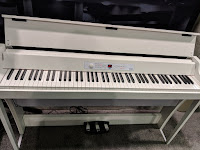 However, just because they are in stereo does not mean that’s the only thing which has changed.Some of those stereo piano (and instrumental sounds such as string symphonies, etc) are so complex that they include more organic elements in the piano sound which makes them sound more natural such as string resonance, sympathetic vibrations, overtones, and other natural sound recreations through new digital piano technology.
However, just because they are in stereo does not mean that’s the only thing which has changed.Some of those stereo piano (and instrumental sounds such as string symphonies, etc) are so complex that they include more organic elements in the piano sound which makes them sound more natural such as string resonance, sympathetic vibrations, overtones, and other natural sound recreations through new digital piano technology.
Some of the non-acoustic piano sounds such as electric pianos, guitars, etc are normally recorded in mono, not stereo. Then there is something called “dynamic voice allocation” which allows the computer chip to allocate certain notes that you are playing to remain being heard even when you are supposedly over the maximum notes of polyphony. Are you getting confused yet? Don’t worry….you should be.
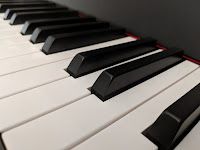 Here’s the bottom line concerning polyphony; the way I judge a digital piano’s ability to have enough polyphony is to play the best stereo piano sound in that digital piano using complex classical music playing as many notes as I can while using the damper-sustain pedal. Trying this method will quickly tell you if you can hear any detectable “note drop-out” while playing the digital piano. With a low polyphony number in other digital piano brands & models, when you play complex music with lots of notes using lots of damper-sustain pedal, you normally will hear sustained notes abruptly stop playing, even if you have those keys pressed down. In other words you just won’t hear them anymore because you have out-played the polyphony. The computer chip just won’t play any more notes until you release most of the other notes being played along with releasing the damper pedal (which resets the polyphony) so that you can play new notes and hear them. Yikes…sounds crazy but that’s the way it works!
Here’s the bottom line concerning polyphony; the way I judge a digital piano’s ability to have enough polyphony is to play the best stereo piano sound in that digital piano using complex classical music playing as many notes as I can while using the damper-sustain pedal. Trying this method will quickly tell you if you can hear any detectable “note drop-out” while playing the digital piano. With a low polyphony number in other digital piano brands & models, when you play complex music with lots of notes using lots of damper-sustain pedal, you normally will hear sustained notes abruptly stop playing, even if you have those keys pressed down. In other words you just won’t hear them anymore because you have out-played the polyphony. The computer chip just won’t play any more notes until you release most of the other notes being played along with releasing the damper pedal (which resets the polyphony) so that you can play new notes and hear them. Yikes…sounds crazy but that’s the way it works!KORG G1 AIR POLYPHONY TEST
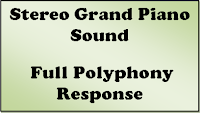 So why am I going into so much detail about polyphony here? It’s because the Korg G1 Air polyphony specification says 120-note maximum polyphony which seems low by today’s standards compared with other digital piano manufacturers having 128-note polyphony, 192-note polyphony, and 256-note polyphony.So people would normally think more is better and less could cause playing problems, right? No, actually not in the case of this G1 Air because of proprietary piano sound sampling technology.
So why am I going into so much detail about polyphony here? It’s because the Korg G1 Air polyphony specification says 120-note maximum polyphony which seems low by today’s standards compared with other digital piano manufacturers having 128-note polyphony, 192-note polyphony, and 256-note polyphony.So people would normally think more is better and less could cause playing problems, right? No, actually not in the case of this G1 Air because of proprietary piano sound sampling technology.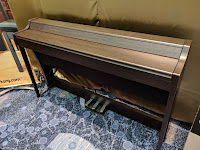 As a matter of fact, the Korg G1 Air sounds like is has almost unlimited polyphony because of how good the sound sample and electronic technology is without note any drop-out interruptions no matter how I played it. When I layered (mixed) a stereo symphony strings on top of the piano sound then occasionally I would hear a few notes drop out when I was playing a many notes while holding the damper pedal, but they were the string sounds dropping out and it was quite subtle due to the dynamic voice allocation system that Korg employs. I’ve had that same thing happen on digital pianos with a higher polyphony specification.
As a matter of fact, the Korg G1 Air sounds like is has almost unlimited polyphony because of how good the sound sample and electronic technology is without note any drop-out interruptions no matter how I played it. When I layered (mixed) a stereo symphony strings on top of the piano sound then occasionally I would hear a few notes drop out when I was playing a many notes while holding the damper pedal, but they were the string sounds dropping out and it was quite subtle due to the dynamic voice allocation system that Korg employs. I’ve had that same thing happen on digital pianos with a higher polyphony specification.
PEDALS
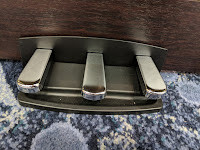 OK…so what is next? It’s got to be the pedals. There are 3 pedals that come with the G1 Air and they play like a real piano. All 3 pedals will do what they are designed to do including soft, sostentuto, and damper-sustain.Since the damper-sustain pedal (the right pedal) is by far the most important pedal as it is used probably 99% of the time, then that’s the one I want to talk about. On the Korg G1 Air, all of the pedals including the damper-sustain pedal have a good amount of resistance when pressing down the pedals and the pedaling mechanism overall is very quiet unlike some other digital pianos which have noisy pedal movement.
OK…so what is next? It’s got to be the pedals. There are 3 pedals that come with the G1 Air and they play like a real piano. All 3 pedals will do what they are designed to do including soft, sostentuto, and damper-sustain.Since the damper-sustain pedal (the right pedal) is by far the most important pedal as it is used probably 99% of the time, then that’s the one I want to talk about. On the Korg G1 Air, all of the pedals including the damper-sustain pedal have a good amount of resistance when pressing down the pedals and the pedaling mechanism overall is very quiet unlike some other digital pianos which have noisy pedal movement. In other words they don’t feel like cheap keyboard pedals and other digital pianos that have pedals that are much too light and noisy and offer little resistance when you press them down which is not good. So the G1 Air pedals definitely feel more realistic. The damper-sustain pedal part of the 3-pedals is important because it controls how much sustain is coming from the notes you are playing. The damper pedal needs to offer the half-damper mode which allows for a variable amount of sustain instead of just on & off.
In other words they don’t feel like cheap keyboard pedals and other digital pianos that have pedals that are much too light and noisy and offer little resistance when you press them down which is not good. So the G1 Air pedals definitely feel more realistic. The damper-sustain pedal part of the 3-pedals is important because it controls how much sustain is coming from the notes you are playing. The damper pedal needs to offer the half-damper mode which allows for a variable amount of sustain instead of just on & off.
That’s why when you hear a ginormous 9′ grand piano sound, it’s so beautiful because there is so much tone and sustain going on in the piano. Long decay/sustain time is very important in creating beautiful, resonate music with the piano strings vibrating and resonating together over time.
 OK, now that you know all of this detail about pedal decay/sustain time and sustained note volume, here’s why I brought it up; many digital pianos have very little pedal decay-sustain time for their piano sounds.In fact some digital pianos fade out in less than 6 seconds of time, which is terrible. One of the big reasons for such poor pedal sustain is because they use a cheaper piano sound chip with a small amount memory that cannot hold a note for more than a few seconds.
OK, now that you know all of this detail about pedal decay/sustain time and sustained note volume, here’s why I brought it up; many digital pianos have very little pedal decay-sustain time for their piano sounds.In fact some digital pianos fade out in less than 6 seconds of time, which is terrible. One of the big reasons for such poor pedal sustain is because they use a cheaper piano sound chip with a small amount memory that cannot hold a note for more than a few seconds.INSTRUMENT SOUNDS & CONTROL PANEL



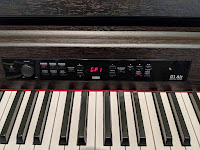 The Korg G1 has 32 total instrument sounds which are located inside of 4 instrument sound buttons on the front control panel with 7 of those instruments being the acoustic piano sounds from the 3 piano sound buttons as I mentioned before. All sounds are displayed in the small LED display screen in red letters. The non-acoustic piano sounds such as electric pianos, organs, strings, choirs, harpsichord, bass, and other tones are found inside the “others” button and are exceptionally realistic as compared to many other digital pianos in this price range including Yamaha, Roland, etc. Those instrument sounds I mentioned are very dynamic which means they change tonal character as you play the keys softly or play the keys with more velocity and more force. The sounds really come alive as you put more expression into your music and those sounds are not just static like they are on other digital pianos.
The Korg G1 has 32 total instrument sounds which are located inside of 4 instrument sound buttons on the front control panel with 7 of those instruments being the acoustic piano sounds from the 3 piano sound buttons as I mentioned before. All sounds are displayed in the small LED display screen in red letters. The non-acoustic piano sounds such as electric pianos, organs, strings, choirs, harpsichord, bass, and other tones are found inside the “others” button and are exceptionally realistic as compared to many other digital pianos in this price range including Yamaha, Roland, etc. Those instrument sounds I mentioned are very dynamic which means they change tonal character as you play the keys softly or play the keys with more velocity and more force. The sounds really come alive as you put more expression into your music and those sounds are not just static like they are on other digital pianos.
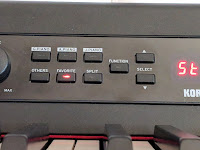
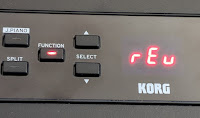
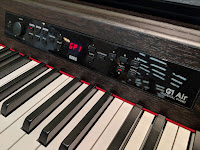 Within the front control panel which is conveniently placed up and behind the keyboard just below the sheet music holder, there are a few other useful buttons, two of which are called function and select. They allow you to quickly access some of the other useful features in this digital piano including changing the reverb effects, chorus effects, brightness control (which can bright or soften the overall piano sound), transpose key for automatically playing or singing in a different key, touch sensitivity of the keyboard to adjust for the way you play the keys, relative volume controls for sounds, layer controls, and many other features.
Within the front control panel which is conveniently placed up and behind the keyboard just below the sheet music holder, there are a few other useful buttons, two of which are called function and select. They allow you to quickly access some of the other useful features in this digital piano including changing the reverb effects, chorus effects, brightness control (which can bright or soften the overall piano sound), transpose key for automatically playing or singing in a different key, touch sensitivity of the keyboard to adjust for the way you play the keys, relative volume controls for sounds, layer controls, and many other features.That works good and if you have a favorite “layered or mixed” combination of two sounds that you use often then you can choose to save that “layered” sounds as well for instant recall. When it comes to the internal sound library in the G1, if you want to layer (mix) any two sounds together to play at the same time, you just press two sound buttons together at the same time and you’ll get an instant layer. One quick comment worth mentioning is that the function button features are not convenient to use as well as being somewhat cryptic to find.
EDITING MODE TO SAVE SETUP
 ith regard to using the editing features & setups, it is worth mentioning that Korg implemented a function in the editing mode that saves the last set-up that you used just before you turn off the piano. Then when you power up the piano next time you want to play, that previous set-up instantly comes back on which can be a good thing if you want to use that setting often when you play the G1 Air.
ith regard to using the editing features & setups, it is worth mentioning that Korg implemented a function in the editing mode that saves the last set-up that you used just before you turn off the piano. Then when you power up the piano next time you want to play, that previous set-up instantly comes back on which can be a good thing if you want to use that setting often when you play the G1 Air.RECORDING & PLAYBACK FEATURES
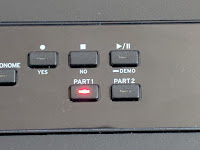 On the right side of the control panel there are some other buttons which control the digital metronome and the 2-track (2-part) MIDI recorder. The MIDI recorder is useful, especially for students because it allows you record your left and right hand independent of each other and then play them back that way so you can hear how your right and left hand parts are doing by listening to them apart from each other. Then when you have done that you can play back both recorded parts at the same time to hear how the song is doing and to see if you need to make improvements. You can use the digital metronome and set it
On the right side of the control panel there are some other buttons which control the digital metronome and the 2-track (2-part) MIDI recorder. The MIDI recorder is useful, especially for students because it allows you record your left and right hand independent of each other and then play them back that way so you can hear how your right and left hand parts are doing by listening to them apart from each other. Then when you have done that you can play back both recorded parts at the same time to hear how the song is doing and to see if you need to make improvements. You can use the digital metronome and set it
to any time signature and tempo you want which helps with rhythm and timing training while you are learning your songs. In the recorder section you are able to play and save up to whopping 99 individual songs in the the piano including 999 measures (or 45,000 notes) in each song. This is way more internal song memory than most digital pianos in this price range which may have the capacity of 1, 2 or 3, or 10 songs at most. The G1 Air does not have audio wav or MP3 recording as a few other pianos have not does the piano have a USB flash drive input to load or save songs.
PIANO PARTNER MODE
 Speaking of lesson practice, the G1 Air also has a Piano Partner mode which allows 2 people (siblings, friends, parent-child, teacher student) to practice the same song at the same time using the same notes coming out in the same octaves. This happens by the piano electronically dividing the 88 keys into two 44-note keyboards so that one person plays 2-hands on one side of the middle C and the other person plays 2 hands on the other side of middle C. The piano automatically adjusts the left part of the keyboard (the bass section) to sound identical to the right side of the keyboard (the treble section). Other digital pianos have this mode too and it can be called duet mode, 4-hand mode, twin mode, etc.
Speaking of lesson practice, the G1 Air also has a Piano Partner mode which allows 2 people (siblings, friends, parent-child, teacher student) to practice the same song at the same time using the same notes coming out in the same octaves. This happens by the piano electronically dividing the 88 keys into two 44-note keyboards so that one person plays 2-hands on one side of the middle C and the other person plays 2 hands on the other side of middle C. The piano automatically adjusts the left part of the keyboard (the bass section) to sound identical to the right side of the keyboard (the treble section). Other digital pianos have this mode too and it can be called duet mode, 4-hand mode, twin mode, etc.CONNECTIVITY & INTERNAL SPEAKER SYSTEM
 The connectivity available for this piano is pretty much what most people are looking for which includes separate line audio output jacks, MIDI in & out connectors, USB to device connector, and 2 stereo headphone jacks. The only thing missing that I would have preferred to see is an audio stereo line input jack to connect outside audio to go through the G1 Air speaker system. This would be useful to hear your music coming from your external personal device and being fed directly through the piano speaker system is that device did not have Bluetooth connectivity.. I say that especially because the G1 Air speaker system is by far the most powerful speaker system of any major brand or model under $2000 that I know of.
The connectivity available for this piano is pretty much what most people are looking for which includes separate line audio output jacks, MIDI in & out connectors, USB to device connector, and 2 stereo headphone jacks. The only thing missing that I would have preferred to see is an audio stereo line input jack to connect outside audio to go through the G1 Air speaker system. This would be useful to hear your music coming from your external personal device and being fed directly through the piano speaker system is that device did not have Bluetooth connectivity.. I say that especially because the G1 Air speaker system is by far the most powerful speaker system of any major brand or model under $2000 that I know of.
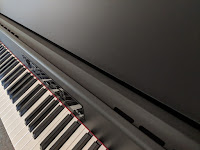 In the G1 Air you can even feel the bass notes bring out the bottom end of the piano sound. Also, being able to clearly hear the higher frequency range without the overall sound being mid-rangy or muddy is no easy task in a small compact digital piano but in my opinion Korg has really nailed it. In other words, whether you play
In the G1 Air you can even feel the bass notes bring out the bottom end of the piano sound. Also, being able to clearly hear the higher frequency range without the overall sound being mid-rangy or muddy is no easy task in a small compact digital piano but in my opinion Korg has really nailed it. In other words, whether you playBLUETOOTH WIRELESS AUDIO


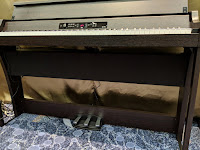 So, given that Korg has such an impressive internal speaker system in this model, what else can Korg do to follow that act? OK…here’s something very cool (and useful) that no other major digital piano brand in this price range can do. The Korg G1 Air has built-in Bluetooth wireless audio. In other words, you can take your Bluetooth device such as an iPhone, iPad, etc (I use iPad a lot) and play your favorite MP3 song files on your device (iTunes) through the G1 Air speaker system. This is a very special bonus you get with the G1 Air because now your piano can become your in-home high definition, high quality speaker system to play your songs through.
So, given that Korg has such an impressive internal speaker system in this model, what else can Korg do to follow that act? OK…here’s something very cool (and useful) that no other major digital piano brand in this price range can do. The Korg G1 Air has built-in Bluetooth wireless audio. In other words, you can take your Bluetooth device such as an iPhone, iPad, etc (I use iPad a lot) and play your favorite MP3 song files on your device (iTunes) through the G1 Air speaker system. This is a very special bonus you get with the G1 Air because now your piano can become your in-home high definition, high quality speaker system to play your songs through.
CABINET DESIGN & CONSTRUCTION


 Now we’re near the end of this report…finally! I did want to talk about the G1B Air Furniture CABINET because it’s impressive. For a small compact furniture cabinet digital piano, it actually has a nice designer look to it with its curved side panel legs, attached front support legs for extra front support and stability, and raised front header console where the control panel is placed. The piano cabinet has the new “privacy panel” that covers up the back of the piano under the speaker box and makes it look more attractive. another digital piano under $2000 with a full privacy panel in back is the newer Casio Celviano AP-470 which you can check out here: Casio AP-470 Review.
Now we’re near the end of this report…finally! I did want to talk about the G1B Air Furniture CABINET because it’s impressive. For a small compact furniture cabinet digital piano, it actually has a nice designer look to it with its curved side panel legs, attached front support legs for extra front support and stability, and raised front header console where the control panel is placed. The piano cabinet has the new “privacy panel” that covers up the back of the piano under the speaker box and makes it look more attractive. another digital piano under $2000 with a full privacy panel in back is the newer Casio Celviano AP-470 which you can check out here: Casio AP-470 Review.
The G1 Air has low power consumption, has automatic power shut off in case you forget to turn it off when you’re through playing it, and Korg products are known to last not just years, but decades. The factory warranty is currently 5 years parts and 5 years labor after you register the piano on-line with Korg.That warranty time is huge and larger than most of the other digital piano companies out there incl Yamaha, Roland, Kawai, etc for instruments under $2000
SHEET MUSIC SUPPORT
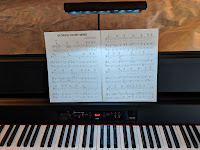 1. The height position of the music rest above the keyboard is more in the line-of-sight of someone reading sheet music than many other contemporary compact digital pianos can do because those other digital pianos typically have the music rest on the same level as the keyboard just behind the keyboard. Having the music sitting up at a higher position (like a real piano) can reduce neck strain, eye strain, and it allows the player/student to experience reading the sheet music in a more normal way.
1. The height position of the music rest above the keyboard is more in the line-of-sight of someone reading sheet music than many other contemporary compact digital pianos can do because those other digital pianos typically have the music rest on the same level as the keyboard just behind the keyboard. Having the music sitting up at a higher position (like a real piano) can reduce neck strain, eye strain, and it allows the player/student to experience reading the sheet music in a more normal way.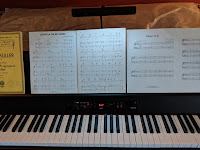 There is a smaller groove built into the front top of the piano (see above pictures in previous cabinet info/comments) that spans the entire width of the piano which not only allows extra piano sound to project up & out of the piano (like what a grand piano does when the lid is open), but this groove can be use to physically hold sheet music and books for the entire width of the piano top and that music then has back support from the key-cover which acts as a natural backing for the music to stand up and be supported.
There is a smaller groove built into the front top of the piano (see above pictures in previous cabinet info/comments) that spans the entire width of the piano which not only allows extra piano sound to project up & out of the piano (like what a grand piano does when the lid is open), but this groove can be use to physically hold sheet music and books for the entire width of the piano top and that music then has back support from the key-cover which acts as a natural backing for the music to stand up and be supported.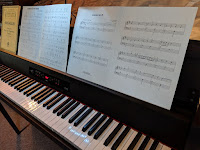 entire piano. This is very cool, especially for someone playing a more complex piece of music with multiple pages of music or for someone who wants more than one music book on their music stand at the same time. The Korg G1 Air does this in a way that few other digital pianos can.
entire piano. This is very cool, especially for someone playing a more complex piece of music with multiple pages of music or for someone who wants more than one music book on their music stand at the same time. The Korg G1 Air does this in a way that few other digital pianos can.KORG DIGITAL PIANO FACTORY
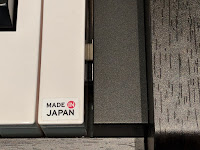 One more thing that I nearly forgot. Most of the Japanese brands including Yamaha, Casio, Kawai, and Roland design their digital piano products in Japan but have them built and assembled in other countries such as China, Indonesia, and Malaysia, as I mentioned earlier. That’s fine as long as the manufacturer owns and runs the factory in that other country. Quality control in products is extremely important and all the strong, respected digital piano companies want their products to turn out good. However, having them build their products in Japan itself can be quite costly because
One more thing that I nearly forgot. Most of the Japanese brands including Yamaha, Casio, Kawai, and Roland design their digital piano products in Japan but have them built and assembled in other countries such as China, Indonesia, and Malaysia, as I mentioned earlier. That’s fine as long as the manufacturer owns and runs the factory in that other country. Quality control in products is extremely important and all the strong, respected digital piano companies want their products to turn out good. However, having them build their products in Japan itself can be quite costly because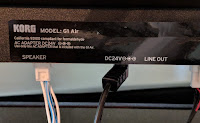 costs of living and wages are so high as compared to many other countries such as China so that’s why the actual manufacturing for these digital piano companies don’t happen in Japan anymore, they just cannot afford it.
costs of living and wages are so high as compared to many other countries such as China so that’s why the actual manufacturing for these digital piano companies don’t happen in Japan anymore, they just cannot afford it.FINAL THOUGHTS & MORE CABINET DETAILS
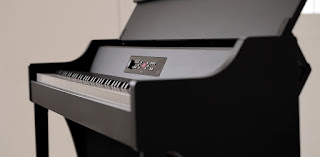 I believe that at the end of the day, if you cannot find something to like about this new digital piano model then you are not trying very hard! If you want a piano primarily to play piano on with fewer bells & whistles than other digital pianos (but still with some cool ones like I described earlier), and you’re also wanting impressive grand piano playing sound quality and a satisfying piano playing experience for under $2000, then in my opinion you cannot miss with the new Korg G1 Air.
I believe that at the end of the day, if you cannot find something to like about this new digital piano model then you are not trying very hard! If you want a piano primarily to play piano on with fewer bells & whistles than other digital pianos (but still with some cool ones like I described earlier), and you’re also wanting impressive grand piano playing sound quality and a satisfying piano playing experience for under $2000, then in my opinion you cannot miss with the new Korg G1 Air. The matte black finish with the back privacy panel is still the most popular cabinet color in any digital piano these days, although I must admit that I also like the all white cabinet color as it looks “clean & modern” and is a popular color right now. This is because so many homes have matte white interiors combined with black color decors.
The matte black finish with the back privacy panel is still the most popular cabinet color in any digital piano these days, although I must admit that I also like the all white cabinet color as it looks “clean & modern” and is a popular color right now. This is because so many homes have matte white interiors combined with black color decors.If you want more info on these pianos and lower prices than internet, Amazon, bundles, or store discounts in the USA, please email us at tim@azpianowholesale.com or call direct at 602-571-1864

















Very good review,Tim. Since this board only allows Bluetooth audio for songs,can you connect your I pad via USB to host and utilize your I pad apps with this digital piano?. Thanks for having this review of the g1 air.It looks like a bargain for what it does.
Px870 vs korg air, which one do you recommend?
Wow, you basically convinced me to buy this piano!
What can you tell about piano action being kinda old for 2018, key wobbles and clicks? I was considering Kawai ES8, but its much more expensive with the stand.
Howard, I have updated my G1 review to make my USB comments more clear with regard to your question. Yes, you certainly can use MIDI interactive apps for tablet by connecting a USB cable (and adapter) to an iPad from the tablet. If you live in the US and want a G1 or other digital piano then please email me and I can help arrange for you to purchase for even less money than internet and amazon discount pricing.
The Kawai ES8 is at a different level of piano sound sampling key action, and pedaling. But it should be given it's much higher price range. As for being "old" the ES8 key action, piano sound chip, and pedaling are being used in 2 model Kawai digital pianos with a total of 5 Kawai models using that same key action and many people who own those pianos have great things to say about their playing experiences. Just depends on your budget and preferences
they are both great choices. Just depends on your budget (price range) and also the features and functions that most appeal to you.
If you live in the US and have further questions then please let me know and I can also show you how to purchase either piano brand new for less money than internet and amazon discount pricing.
Hi Tim,
Great review of the Korg G1.
How would you compare the G1 to the Kawai KDP90? The KDP110 is obviously around $300 cheaper($200+$100 for the included bench).
Also what's your opinion on the C1 Air?
Thanks,
John
Thanks Tim .You answered my question.Pleaseskip over this subject in my recent e mail to you. I think this Korg digital piano is probably the best console digital piano in its price range along with the Casio's Px consoles. Keep up the good week- You' re making a difference!
Hi Tim, thanks to your comprehensive and detailed review, I have gotten myself a Korg G1 🙂
In your review, you mentioned that the piano does not have audio WAV and MP3 recordings. So, how can one still make a recording of the songs to be played back on the computer?
you could purchase an external audio wav/MP3 stereo recorder and connect it to the audio output of the piano. You would then record your audio performance on that device and save it to a USB flash drive or memory card and then transfer that recorded song into your computer for storage and use in software programs. The external audio recorders are generally quite inexpensive…near or under $200US. Then you would get what you are asking about.
A clarification on the USB port on the G1 Air is that besides its possible use as a MIDI connection, it also has an alternative USB storage mode. While the G1 Air cannot export audio wav/MP3 files, if you need more than the 99 recording slots built in (or if you just want to back up to or restore from a computer your compositions), you can do so using the USB port.
For both the C1 Air and G1 Air, although you don't have built-in bluetooth MIDI to connect to iPad app like some other piano brands, you can use a Yamaha or Quicco bluetooth MIDI adapter instead of a cable, particularly since they only cost about $5-$10 more than a physical cable. For the G1 Air you can also use a Bluetooth USB adapter, though it requires power and costs about the same as the MIDI version, so it isn’t the preferred solution.
A good choice for a Bluetooth MIDI adapter that works well with the G1 Air is the Yamaha MD-BT01, so you can keep your USB port open to use as a means to back up songs from the piano to a computer and still have a wireless connection to an iPad.
Dear Tim,
What do you think about Roland 140.
Compared to korg G1?
Hi Tim,
My new piano arrived yesterday afternoon, assembled easily, and plays beautifully!
Thanks so much for another smooth exchange. You deliver such great value through your in-depth reviews, and of course, your factory direct prices are icing on the cake.
Having bought two pianos through you this past year (this one, and the Kawai ES8 for my girlfriend), I don't anticipate being in the market again anytime soon, but when I hear of others who are, I'll be sure they at least visit your site before they make any buying decisions.
Thanks again,
Chad
Update: one week in and I'm in Love! Great action, amazing sound – through the speakers and through headphones, and a total bonus that it's now my stereo system for playing mp3's from my phone or computer. Awesome!
Chad, happy to hear you love your new piano and that it is living up to your expectations! This is why I do what I do…to help people become musically happy with the right digital piano that will fit their musical needs and budget, and also be a long term enjoyable experience.
Hi Tim,
I'd like to ask, how would you compare Korg G1 to Roland DP603? The depth of the cabinet is crucial for me that's why I have narrowed down the search to these two instruments. I will be playing mostly on headphones. In my region the Korg is approximately 400 Euro cheaper.
As I understand both have excellent and quiet action and Korg might have more natural piano sound.
Is there something that would make you choose Roland over Korg?
Thank you!
My god where can i start, i've been playing piano for about 1 year and a half but i never owned a piano so i only played whenever i could find a public one somewhere, a couple of months ago i decided to start looking for a digital piano and you are the only reviewer online that i really trust, i've been reading a lot of your reviews and every single one is just amazing, the amount of quality in the information you give is remarquable, your critics always feel geniune/unbiased wich is hard to find online, i have a budget of around 1500$ and thanks to your reviews i think i have my mind set on the Korg G1 Air, i only care about the key action and the regular grand piano sound, all the other features that digital pianos have are irrelevant for what i'm looking for, i do have one question about the key action on the G1 air, i've only tried a couple digital pianos (up to 3000$) in a music store and the thing that bugged me the most is that towards the top part of each key it gets a lot harder to press (compared to a yamaha baby grand that i'm used to playing) i would assume that it's because digital piano cabinets are not very deep so there isn't enough space to get a more balanced pressing feel up and down each individual key but that's just a guess, do you understand the issue i'm describing? does it apply to the G1 air?
and again great reviews man the time you put in each one really shows.
yes, a grand piano key action with much longer keys is easier to play because of the extended key length and balance points from front to back of each key. This is normal. On acoustic upright pianos the backs of the keys are noticeably firmer to the touch than the fronts of the keys simply due to mechanics in the upright key action design. And yet most people in the US who own and play acoustic pianos have upright pianos with the upright key actions, and their teachers don't complain because this is just they way those pianos are and much music can be made on them. The G1 Air like just about all other digital piano key actions have keys more like upright acoustic pianos in terms of key weight…but that's fine and is normal. Only for people who regularly play acoustic grand pianos will they notice a difference. To get a "grand piano type key action" in a digital piano would require spending at least twice as much money as compared to the G1 Air.
Hi, amazing site and really really useful reviews, all to the point. I am about to choose between Korg G1 and Casio PX870. i know there is a difference in price range but is there an obvious reason to choose casio over korg? Unfortunately where I live it is hard to try them.
And a crucial question that noone has managed to answer me so far. About G1. If I connect G1 with an IPad via cable, and use it as a midi keyboard for an app, lets say Garageband, can I also connect back IPad with G1 via Bluetooth, so that I can listen to Ipads sound through G1 speakers? If yes, should I expect serious lag?
Thanks, and keep doing what you do <3
This comment has been removed by the author.
I had purchased this piano as a gift for my wife today. Hope she likes it.
What would be the equivalent Korg model in a non cabinet digital piano?
The closest Korg portable digital piano to the G1 Air would be the SV2S which sells for about $2500
Thanks for this great review, Tim. Here in the UK I am struggling to find a Korg G1 to try out in person.
One question, in your opinion are the anti-tipping brackets completely necessary? Does the piano tip forward without them? Just thinking of the restricted space in my room.
Many thanks! Simon
The anti-tip brackets that attach to the bottom legs on back of the piano stick out about 3" long. If you have a flat wall that the piano will be sitting against, then brackets will likely be unnecessary because the piano won't be able to tip backwards because of the wall.
The brackets are designed to prevent the piano from tilting backwards and tipping over if there is no hard surface directly behind it. If the piano is not against a wall then the brackets are necessary. I hope this helps. Overall, the G1 Air is a very impressive digital piano when it comes to the piano playing experience and build quality.
Thanks for this great review, seems like a great choice for me. I have one question related to recording myself onto Garageband. I assume this needs to be done by connecting the cable with the midi in/out? Also, would it need special cables to connect?
Thanks,
Arnold in Canada
Thanks Tim – appreciate the blog. I’m in a similar boat to some, having played acoustic pianos growing up and looking for my first digital with a young family.
I want a slim, modern cabinet with a budget of circa £1500 UK. I like the idea of textured keys and preferably wooden (but not essential).
It seems like the Yamaha S55 would fit the bill, but the Kawai CN201 has a better sound (but more traditional cabinet), whilst the Casio PX-S5000 or 6000 is very modern and has wooden keys but will have inferior sound due to the speakers and cabinet. Korg Air could be a good choice but lacks the app etc.
Any other thoughts to consider?
Thanks.
Based on your music needs and criteria, in my opinion the Korg G1 Air would be a great choice. It can connect to iPad, etc and provide great playing/learning experience with many 3rd party music/piano related apps. It does not have it's own proprietary controller app, but the G1 Air is relatively simple to use so it really does not need a controller app.
The internal piano sound engine and internal speaker system make this model sound like an acoustic baby grand piano when it is being played. The non piano instrument sounds are also very impressive and the Bluetooth audio streaming feature can be very useful.
I personally do not like the Yamaha S55 for one main reason; the key action is extremely heavy and can cause hand, finger, and wrist fatigue. Touch-weight measured at middle C for that Yamaha is approx 90 grams! Any piano that has touch weight on middle C over 75 grams is simply not acceptable for recreational playing or even for advanced pianists based on my experience playing all kinds of pianos for many years.
Other than this Korg G1 Air model and a couple of the ones you mentioned, my other suggestion for a great piano playing experience around $2000 or so would be the Kawai ES920.
In addition to all of that, maybe you could design and make your own digital piano to satisfy all your specific needs:)
Great review. I Am struggling to find somewhere local in the south west area of uk to try out the g1. I currently have had cvp6 for 30 years and want the best replacement money will buy. It will be in a small room and cannot be myuch taller or wider than the cvp6. I have short listed the cn301, es920 and the g1. My main need if best piano sound and action for classical music. I like the look /sound of the g1 in photos/ videos on line. I worry it is by far the cheapest. What are your thoughts please?
Colin P
Greetings Tim
I need your opinion on Choosing a Home full Cabinet Digital Piano that I won't need to upgrade for upto 20+ years that's suitable for beginners to Advanced Classical level pianists. That has the most Authentic Action (Keys and pedals) in all aspect with a Authentic Piano sound Sampled or modeled , Durable and Sturdy built in cabinet and internal Action in the $2K range max.. I think I'm down to these 3 options (Roland HP-704/Korg G1B Air/Casio AP-470) although not sure if any of these three fits the bill that's why I need your opinion. Also do you ship worldwide?
Thanks
Hi Tim – great review.
Assuming a both were within budget, would you choose a Yamaha CSP 170/275 or the G1 air and save ~$1,000?
How would you compare the key action of this piano to that of Roland HP704? Would you unequivocally say that the Roland would be a step up, given the price difference?